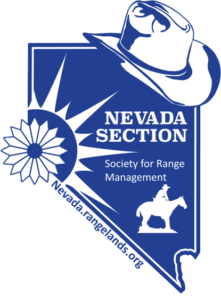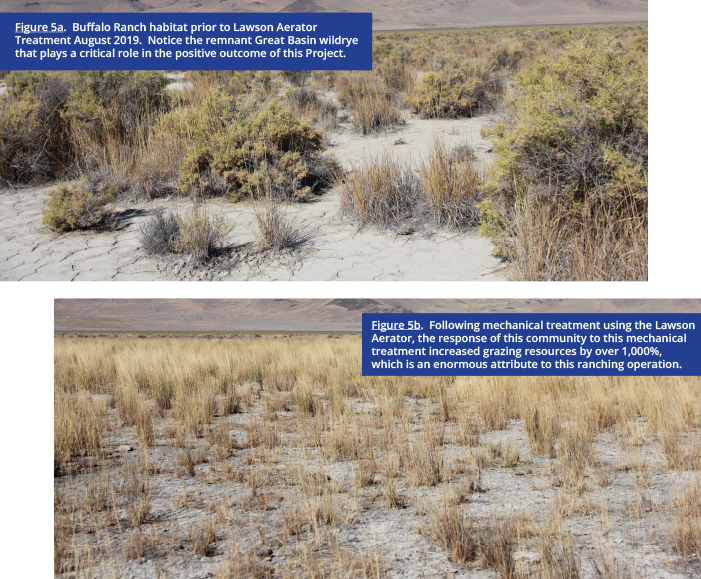 Grazing resources are often limited due to older more decadent shrub communities that use up valuable and limited resources at the expense of perennial herbaceous species that provide sustainable grazing resources.
Grazing resources are often limited due to older more decadent shrub communities that use up valuable and limited resources at the expense of perennial herbaceous species that provide sustainable grazing resources.
Traditional range improvement practices that include mechanical and chemical control of old, decadent, dense stands of shrubs can be beneficial in improving stand densities of perennial herbaceous species.
Heavy duty implements designed and built for manipulating rangeland vegetation and soils have been around for many decades.
In the 1950’s, the early development of the Rangeland Drill resulted in the effective seeding of hundreds of thousands of acres of big sagebrush rangelands to increase perennial grasses in an effort to curb erosion, reduce the spread of the noxious weed Halogeton and increase the forage base for the livestock industry. Rangeland plows, dixie harrows, chaining, brush hogs as well as other pieces of equipment have played an important role in brush control efforts in rangeland improvement efforts.
The Lawson Aerator is one of the newer implements to enter the scene of rangeland improvement projects. Although the Lawson Aerator was originally designed as a pasture renovator in southern states to combat woody species invasion, this implement became more popular in brush control in western states.
The Lawson Aerator is often preferred by resource managers as this implement is noted for killing older sagebrush plants while leaving younger sagebrush plants, results in less soil disturbance, is more aesthetically pleasing following treatments while improving stand age and favorable herbaceous response. The Lawson Aerator has significant weight distributed over 2 tandem drums that are typically 12’ x 3’ diameter with an option of adding liquid to the drums for additional weight. The drums display angled, protruding and spaced 8” x 4” x 1” steel plates with sharpened ends for effective chopping of woody material and penetration into soils for aeration. The variable pitch between the bladed drums can be adjusted to reduce or increase the impact to vegetation while aerators equipped with rubber tires improve transportation (Fig. 1).
Tractors with horsepower ratings of 120-350 are preferred as well as tractors with tracks. The Lawson Aerator is less effective in rocky habitats, experiences poor results in seeding forbs in treated habitats and often requires re-treatments to maintain desired shrub densities as greeseweood can resprout following treatment and species such as rabbitbrush can quickly re-invade the treated site. Prior to any treatment on rangelands, resource managers and land owners must understand the risks in disturbing rangelands to limit unintended consequences such as promoting invasive or noxious weeds such as cheatgrass or medusahead.
Here we report on two separate experiences using the Lawson Aerator on degraded shrub habitats in an effort to improve grazing resources.
Case Study 1: Flying M Ranch
In the fall of 201, we treated approximately 80 acres of old, decadent Basin big sagebrush (Fig. 2) followed up with seeding of numerous species which included; Siberian wheatgrass, Great Basin wildrye, Indian ricegrass, sweet clover, flax, bee plant, dry land alfalfa and ‘Immigrant’ forage kochia.
The site was dominated with an overstory of Basin big sagebrush with a very sparse understory of Indian ricegrass. The soils are a sandy loam and the site averages approximately 7.3” of annual precipitation. Thirty 3 ft² quadrats were randomly placed to record seedling emergence and establishment.
Quadrats were read monthly from April through September for two years. Initial emergence of seeded species averaged 2.7/ft², far below our goal of 12/ft². These seedling density numbers only decrease over time, therefor to meet the establishment goal of 1 plant/ft², a starting density of less than 3/ft² usually results in failure over the hot summer months.
The site received 6.4” of precipitation from October 2013 through September 2014, the seedling year. By September 2014, seeded species densities had significantly decreased to 0.18/ft², and was followed up with 8.6” of precipitation during the second year growing season. By September 2015, seeded species establishment was recorded at 0.12/ft², which is a little more than 1 seeded plant/m², far below the initial goal of 1 established plant/ft² or 10/m². Even though the seeded species did not perform well, the site did experience an increase in creeping grasses such as juncus and creeping rye as well as improving edge effect and stand age vigor of shrubs which attracted numerous wildlife species, including mule deer (Fig. 3). There was an increase in livestock use, but this was minor and far below our goals.
Case Study 2: Buffalo Ranch
In the fall of 2019 and spring of 2020, approximately 900 acres of degraded Great Basin wildryre habitat dominated by old, decadent Basin big sagebrush and greasewood was treated with the Lawson Aerator and seeded at the same time (Fig. 4).
The site was seeded with Great Basin wildrye, tall wheatgrass, Siberian wheatgrass and saltbush. The site was dominated with an overstory of Basin big sagebrush and greasewood intertwined across the habitat with a decent understory of Great Basin wildrye and a sparse density of saltgrass. The soils are a silty loam alkaline with an average annual precipitation of 8.3”. Eight 2-acre plots were step up in a cardinal direction to measure the impact/benefit of manipulating this degraded/decadent community to release remnant perennial herbaceous species and improve grazing resources. Each treated and untreated plot was measured using a randomized 10ft² quadrats that recorded density and weight of herbaceous species.
Quadrats were read monthly from April through September for two years and clipping of herbaceous species took place in September of the second year. The mechanical treatment of this decadent/degraded shrub community resulted in an increase of 675% in density from 0.11 plants/ft² (1.2/m²) in untreated plots to 0.75/ft² (8.1/m²) in treated plots. Forage production increased from 4,580 lbs/ac (5,133 kg/ha) in the untreated plots to 49,511 lbs/ac (55,494 kg/ha) in the treated plots, a 1,080% increase (Fig. 5a & 5b).
The site received 6.1” of precipitation from October 2019 through September 2020, which resulted in poor initial emergence of seeded species averaging 3.2/ft² in May of 2020 with an average establishment of 0.18/ft² by September 2021, where the site received 6.5” of precipitation during the second year.
Even though each site has their own challenges and both sites experienced drought years during the first two years of seedling establishment, the importance of having remnant perennial species present to be released following mechanical treatment with the Lawson Aerator is certainly an important factor in successfully improving grazing resources. Precipitation is always a driving force in successfully seeding degraded arid habitats, therefore, plant material testing over multiple years is needed to better understand exactly how different plant materials will perform in these arid environments and under different precipitation patterns and soil types. Also, seeded species along the edge of treated habitats may experience higher predation during the initial seedling phase as was recorded at the Flying M Ranch Site by the black-tailed jackrabbit, while at a lesser degree at the Buffalo Ranch site by cotton tail rabbits, pronghorn and mule deer.
Using the Lawson Aerator as a mechanical vegetation manipulation tool has significantly increased sustainable grazing resources, while at the same time improved edge affect, shrub stand age, vigor and wildlife use, including mule deer, pronghorn antelope and Hungarian partridge. When there is evidence that perennial grasses are present, such as Great Basin wildrye (Fig. 5a above), it can be very beneficial to manipulate the shrub community and release remnant vegetation and improve stand vigor of shrubs, increase perennial grasses for grazing resources, and wildlife habitat. Land owners and resource managers should take a closer look at using this implement to improve degraded shrub habitats and improve herbaceous species composition.
By Charlie D. Clements and Dan N. Harmon





